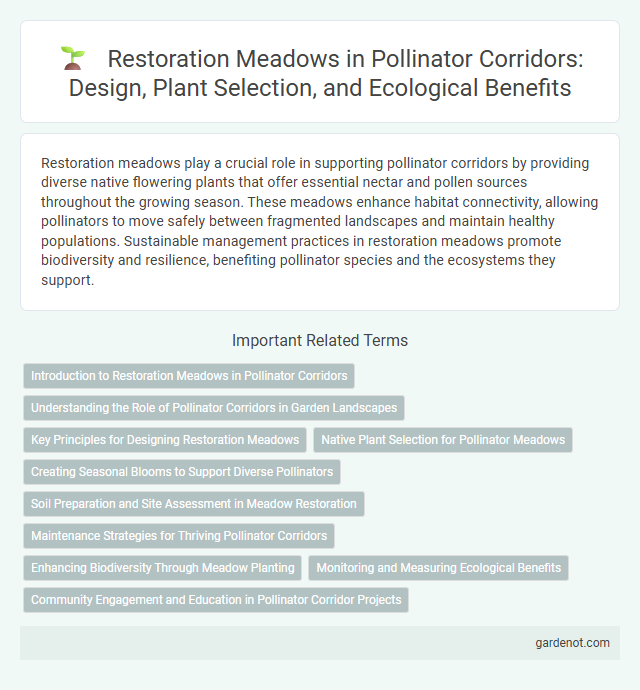Restoration meadows play a crucial role in supporting pollinator corridors by providing diverse native flowering plants that offer essential nectar and pollen sources throughout the growing season. These meadows enhance habitat connectivity, allowing pollinators to move safely between fragmented landscapes and maintain healthy populations. Sustainable management practices in restoration meadows promote biodiversity and resilience, benefiting pollinator species and the ecosystems they support.
Introduction to Restoration Meadows in Pollinator Corridors
Restoration meadows within pollinator corridors serve as critical habitats that support diverse populations of bees, butterflies, and other pollinating insects by providing abundant native flowering plants and nesting sites. These meadows enhance ecological connectivity, facilitating pollinator movement and genetic exchange across fragmented landscapes, which is essential for ecosystem resilience. Implementing native plant species and managing invasive species in restoration meadows directly promotes biodiversity and ecosystem services, contributing to sustainable pollination and agricultural productivity.
Understanding the Role of Pollinator Corridors in Garden Landscapes
Restoration meadows within pollinator corridors provide essential habitats that support diverse insect populations including bees, butterflies, and other pollinators crucial for garden ecosystems. These corridors enhance pollination efficiency by facilitating movement and genetic exchange among pollinator species, promoting resilience in plant communities. Integrating native wildflowers and grasses in restoration meadows increases nectar and pollen availability, thereby strengthening the overall biodiversity and ecological health of garden landscapes.
Key Principles for Designing Restoration Meadows
Restoration meadows designed as pollinator corridors require diverse native plant species to provide continuous bloom throughout the growing season, supporting various pollinator species. Soil preparation must prioritize natural regeneration with minimal disturbance to foster healthy root systems and microbial activity critical for plant establishment. Spatial arrangement and plant density are optimized to enhance habitat connectivity, promote pollinator movement, and ensure ecological resilience against environmental stressors.
Native Plant Selection for Pollinator Meadows
Restoration meadows enhance biodiversity by prioritizing native plant selection, which supports local pollinator species such as bees, butterflies, and hummingbirds. Choosing native wildflowers like purple coneflower (Echinacea purpurea), black-eyed Susan (Rudbeckia hirta), and milkweed (Asclepias spp.) ensures optimal nectar and pollen availability throughout the growing season. Proper native plant composition improves habitat quality, promotes pollinator health, and strengthens the resilience of pollinator corridors.
Creating Seasonal Blooms to Support Diverse Pollinators
Restoration meadows designed with a variety of native flowering plants create seasonal blooms that provide continuous nectar and pollen sources for diverse pollinator species throughout the year. Including early spring wildflowers, summer perennials, and late-blooming asters ensures habitat support for bees, butterflies, and hummingbirds during critical foraging periods. This biodiversity-driven approach enhances pollinator health and promotes ecosystem resilience within pollinator corridors.
Soil Preparation and Site Assessment in Meadow Restoration
Effective pollinator corridor restoration begins with comprehensive site assessment, including soil pH, nutrient levels, and compaction testing to determine suitability for native meadow species. Soil preparation involves removing invasive species, tilling the ground to improve aeration, and incorporating organic matter to enhance soil fertility and moisture retention. These steps ensure optimal conditions for establishing a diverse and resilient meadow that supports native pollinators and promotes biodiversity.
Maintenance Strategies for Thriving Pollinator Corridors
Restoration meadows require targeted maintenance strategies such as selective mowing schedules, invasive species control, and seasonal prescribed burns to promote diverse native plant growth essential for pollinator habitats. Implementing adaptive management based on pollinator population monitoring ensures the corridor supports critical foraging and nesting resources throughout the year. Soil health enhancement through organic amendments and minimal disturbance further stabilizes plant communities, fostering long-term sustainability of thriving pollinator corridors.
Enhancing Biodiversity Through Meadow Planting
Restoration meadows planted with native wildflowers and grasses significantly enhance biodiversity by providing critical habitats for pollinators such as bees, butterflies, and hummingbirds. These meadows support a diverse range of insects and birds, increasing ecosystem resilience and promoting natural pest control. Strategic planting of nectar-rich species ensures year-round forage, sustaining pollinator populations essential for crop pollination and ecosystem health.
Monitoring and Measuring Ecological Benefits
Restoration meadows within pollinator corridors serve as critical habitats, supporting diverse pollinator populations and enhancing biodiversity. Monitoring efforts involve regular surveys of pollinator species abundance, floral diversity, and habitat quality to assess ecological health. Measuring benefits utilizes data on pollination rates, plant reproductive success, and ecosystem services such as improved soil health and carbon sequestration to quantify restoration impact.
Community Engagement and Education in Pollinator Corridor Projects
Restoration meadow projects within pollinator corridors foster community engagement by involving local residents in planting native wildflowers and monitoring pollinator activity to enhance biodiversity. Educational programs teach participants about the critical roles of pollinators such as bees, butterflies, and hummingbirds in ecosystem health and food production. Collaborations with schools and environmental organizations increase awareness and empower communities to sustain pollinator habitats effectively.
Restoration meadow Infographic

 gardenot.com
gardenot.com